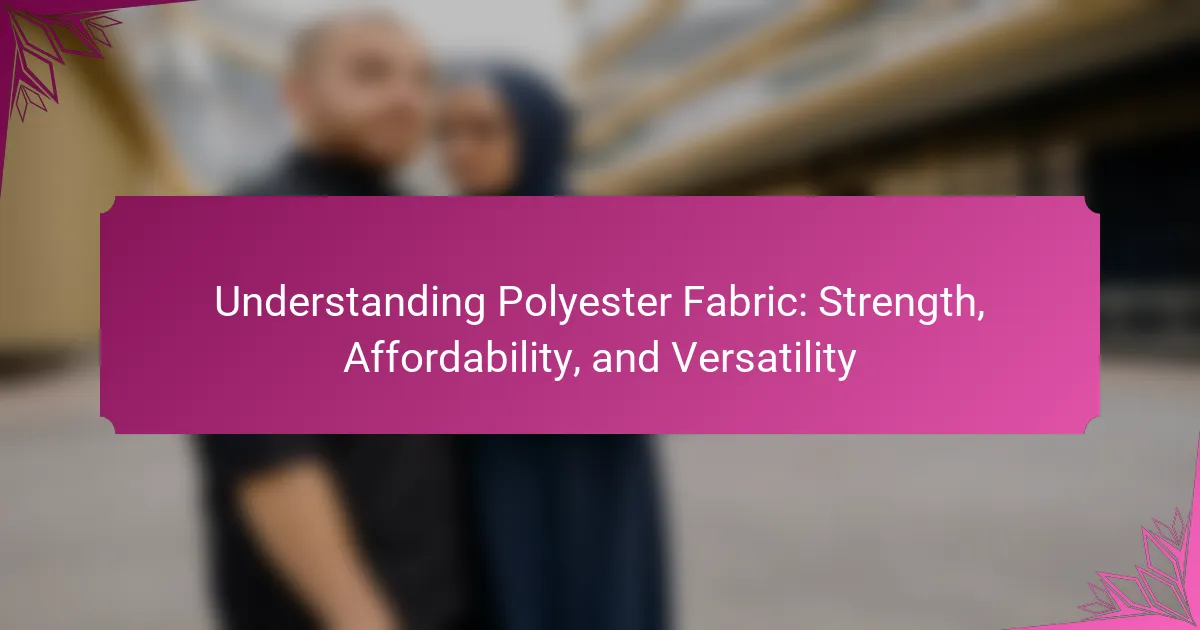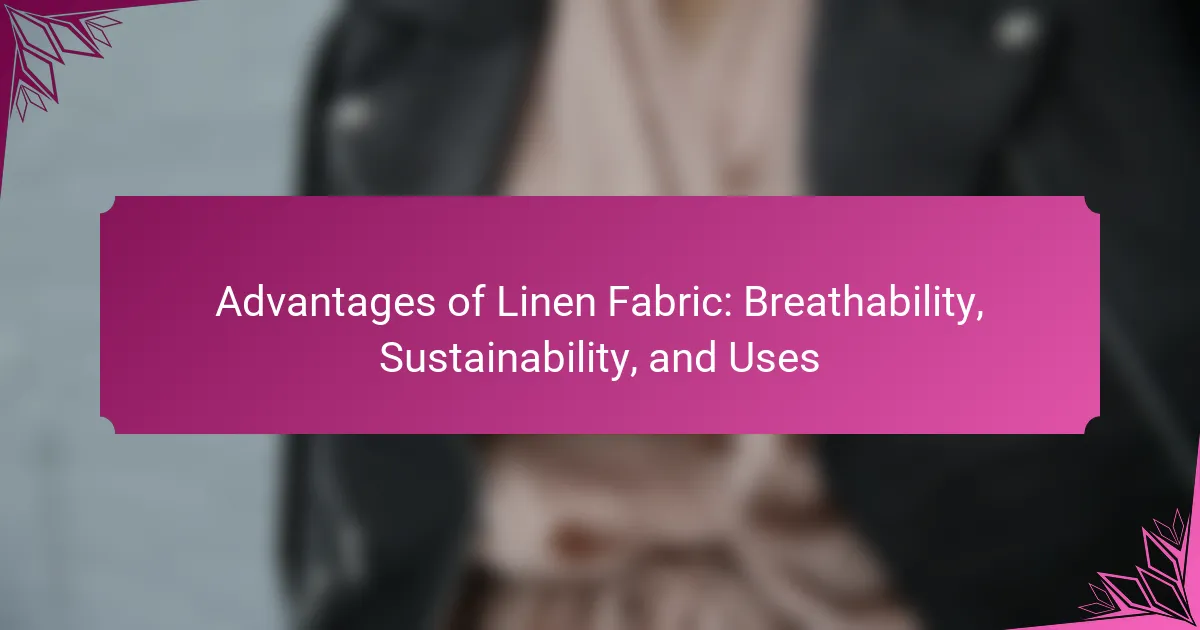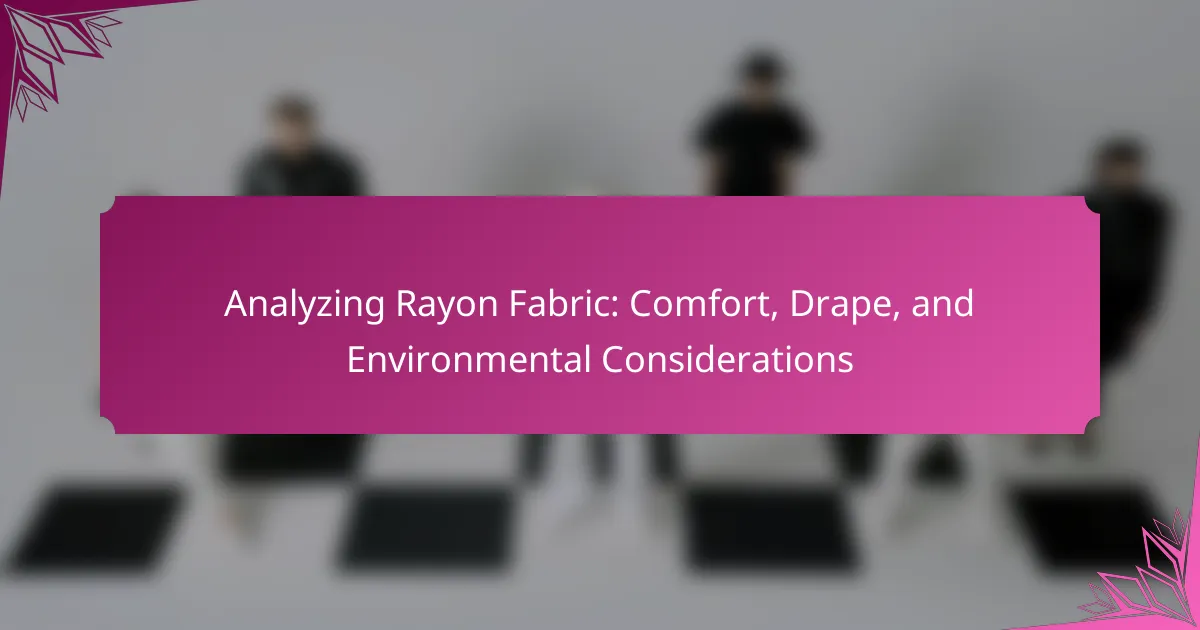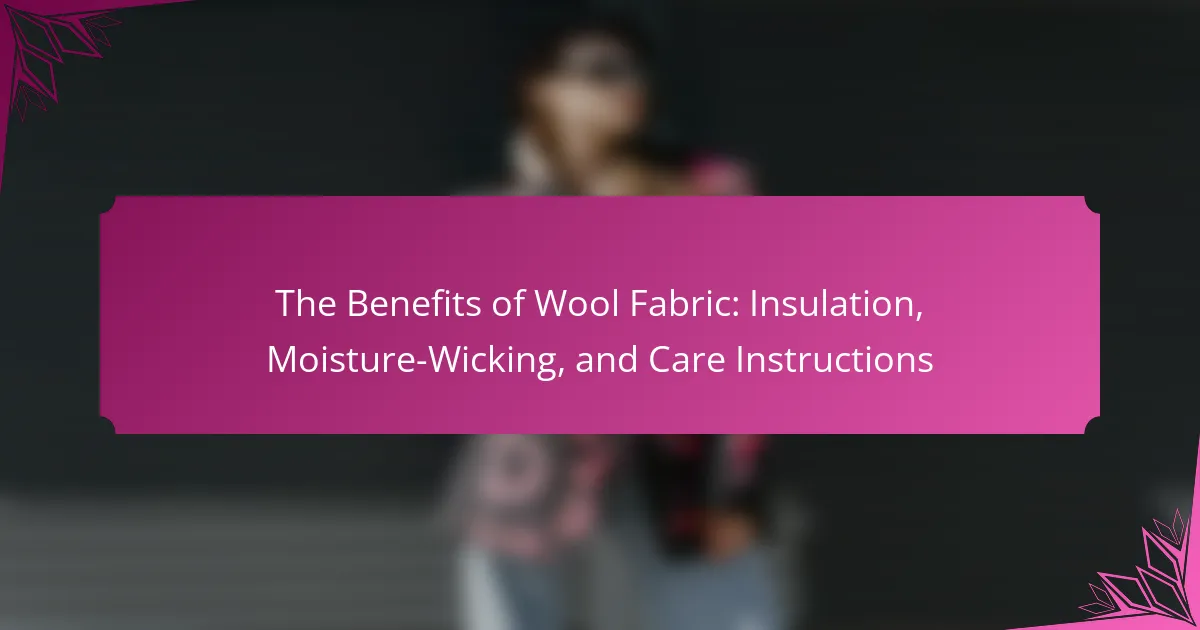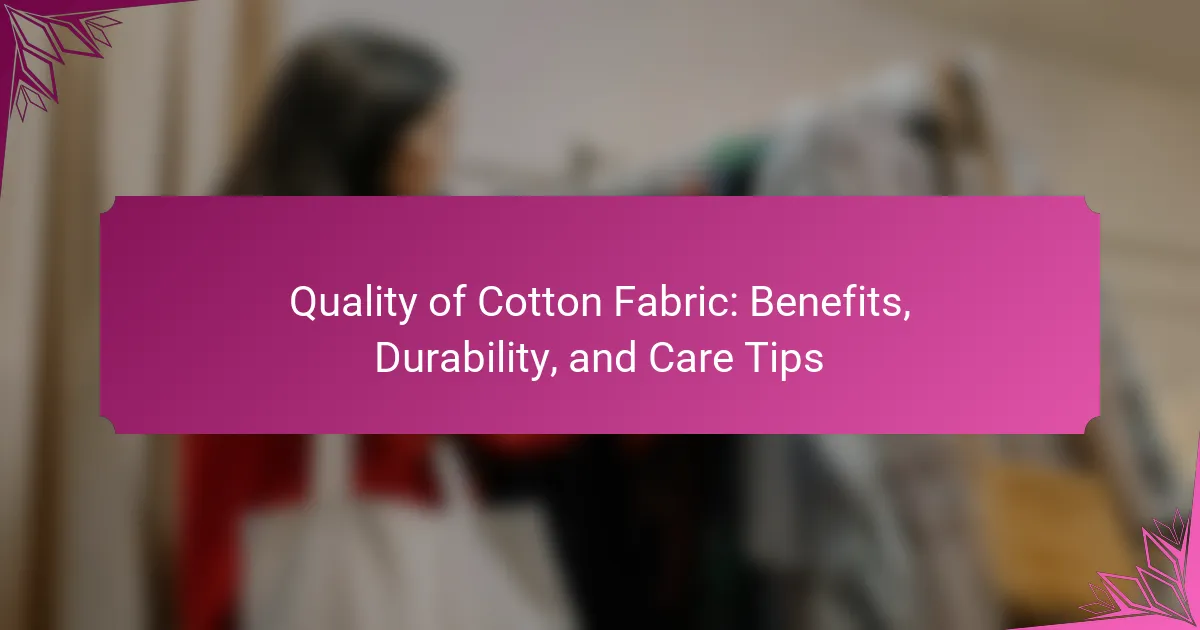Polyester fabric is a synthetic textile made from polyester fibers, recognized for its durability and resistance to shrinking, stretching, and wrinkles. This fabric is commonly utilized in clothing, upholstery, and various household items due to its affordability and quick-drying properties, making it ideal for activewear and outdoor gear. While polyester offers advantages such as easy maintenance and versatility through blending with other fibers, it also has limitations, including reduced breathability, susceptibility to static cling, and environmental concerns related to biodegradability. Understanding these characteristics of polyester fabric is essential for making informed choices in textile applications.
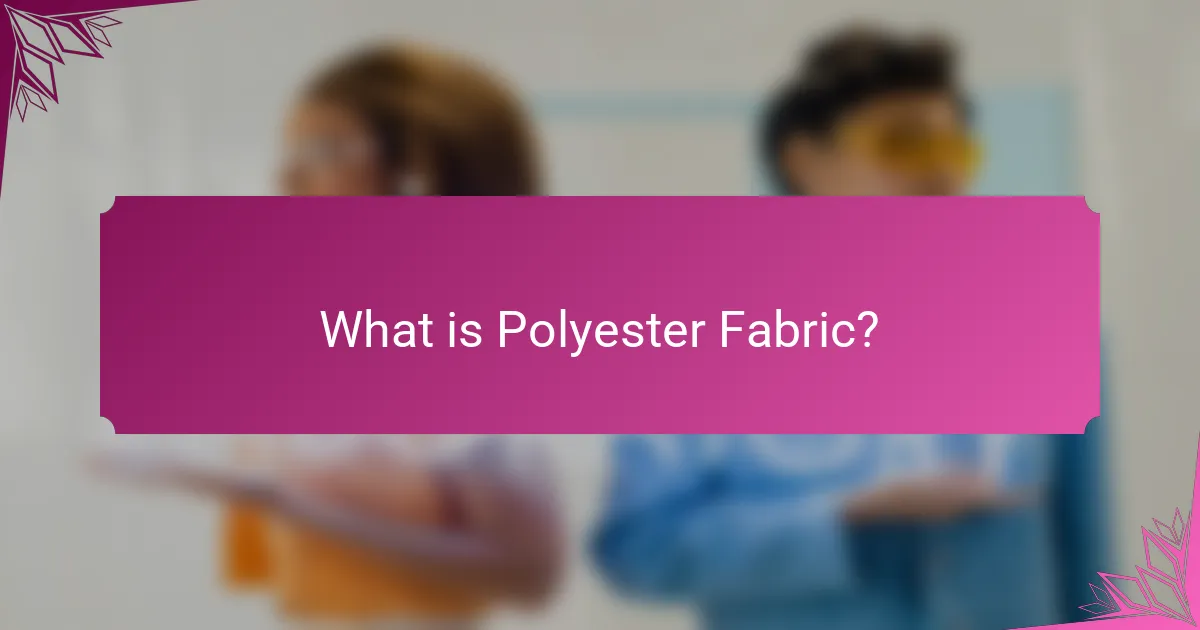
What is Polyester Fabric?
Polyester fabric is a synthetic textile made from polyester fibers. It is known for its durability and resistance to shrinking and stretching. Polyester is commonly used in clothing, upholstery, and various household items. The fabric is also resistant to wrinkles and fading, making it a popular choice for many applications. Polyester can be easily blended with other fibers, enhancing its versatility. This fabric is often more affordable than natural fibers like cotton or silk. Its quick-drying properties make it suitable for activewear and outdoor gear. Overall, polyester fabric combines strength, affordability, and versatility in various uses.
How is Polyester Fabric made?
Polyester fabric is made through a chemical process called polymerization. This process begins with the reaction of petroleum-based products, such as ethylene glycol and terephthalic acid. The resulting polyester polymer is then melted and extruded through spinnerets to form long fibers. These fibers are cooled and solidified, creating strands of polyester. Afterward, the fibers are cut to desired lengths and can be spun into yarn. The yarn is then woven or knitted to create the final fabric. Polyester is valued for its durability, resistance to shrinking, and quick-drying properties, making it a popular choice in textiles.
What raw materials are used in the production of Polyester Fabric?
Polyester fabric is primarily produced from raw materials such as polyethylene terephthalate (PET). PET is derived from the reaction between ethylene glycol and terephthalic acid. This combination creates a polymer that can be spun into fibers. Additionally, other materials like recycled plastics can also be used in polyester production. The use of recycled PET reduces environmental impact. Polyester is known for its durability and resistance to shrinking and stretching. These characteristics make it a popular choice in the textile industry.
What processes are involved in creating Polyester Fabric?
The processes involved in creating polyester fabric include polymerization, spinning, weaving or knitting, and finishing. Polymerization is the initial step where ethylene glycol and terephthalic acid undergo a chemical reaction to form polyester. This results in a thick, viscous liquid known as molten polyester.
Next, the molten polyester is extruded through spinnerets, forming long strands of filament in a process called spinning. These filaments are then cooled and solidified, creating polyester fibers.
Following this, the fibers are either woven or knitted into fabric. Weaving involves interlacing threads at right angles, while knitting uses loops of yarn to create a flexible fabric.
Finally, the fabric undergoes finishing processes. This may include dyeing, printing, and applying treatments for texture and durability. These processes enhance the fabric’s appearance and performance characteristics.
What are the key characteristics of Polyester Fabric?
Polyester fabric is a synthetic material known for its durability and versatility. It is resistant to shrinking and stretching, which helps maintain its shape over time. Polyester is also quick-drying, making it ideal for active wear and outdoor clothing. The fabric is often wrinkle-resistant, reducing the need for ironing. Additionally, polyester can be blended with other fibers for enhanced properties. It is also colorfast, meaning it retains dye well, ensuring vibrant colors. The fabric is lightweight yet strong, contributing to its widespread use in various applications.
What makes Polyester Fabric strong and durable?
Polyester fabric is strong and durable due to its synthetic fiber composition. The fibers are made from polyethylene terephthalate (PET), which is known for its high tensile strength. This strength allows polyester to resist stretching and shrinking. Additionally, polyester has excellent resistance to abrasion, making it suitable for various applications. The fabric also has a low moisture absorption rate, which helps maintain its integrity over time. Furthermore, polyester is resistant to mildew and mold, enhancing its longevity. These attributes combine to make polyester a popular choice for clothing and upholstery.
How does the affordability of Polyester Fabric compare to other fabrics?
Polyester fabric is generally more affordable than many natural fabrics, such as cotton and silk. The production cost of polyester is lower due to its synthetic nature. This fabric is made from petroleum-based products, which are less expensive than the agricultural processes needed for natural fibers. For example, polyester can cost around $2 to $5 per yard, while cotton typically ranges from $5 to $10 per yard. Additionally, silk can cost upwards of $20 per yard. The affordability of polyester makes it a popular choice for various applications, including clothing and home textiles. Its low cost does not compromise its durability or versatility, further enhancing its appeal in the market.
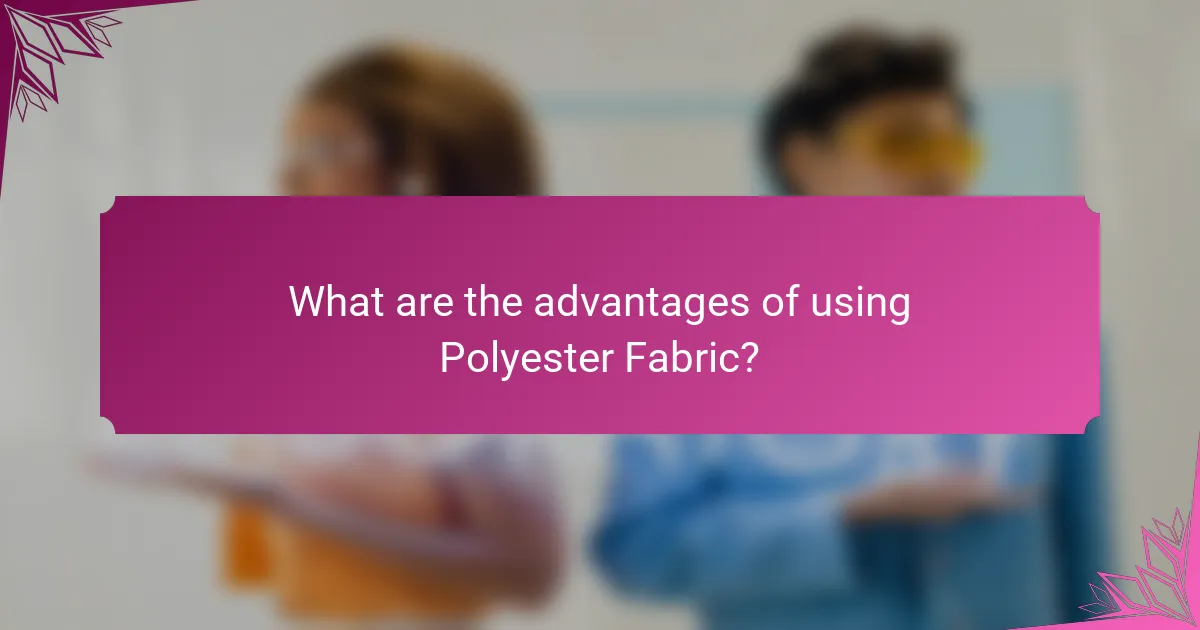
What are the advantages of using Polyester Fabric?
Polyester fabric offers several advantages. It is highly durable and resistant to wear and tear. Polyester maintains its shape well, reducing the likelihood of wrinkles. This fabric dries quickly, making it ideal for activewear and outdoor clothing. Additionally, polyester is resistant to shrinking and stretching, ensuring longevity. It is also affordable compared to natural fibers, making it accessible for various applications. Polyester is easy to care for, requiring minimal maintenance. It can be blended with other fibers, enhancing versatility in fabric use. These attributes make polyester a popular choice in the textile industry.
Why is Polyester Fabric considered versatile?
Polyester fabric is considered versatile due to its wide range of applications and properties. It is resistant to stretching and shrinking, making it suitable for various clothing types. Polyester dries quickly, which is beneficial for activewear and outdoor gear. The fabric is also wrinkle-resistant, maintaining a neat appearance over time. Additionally, it can easily blend with other fibers, enhancing its usability in textiles. Its durability ensures longevity in products, from apparel to home furnishings. Polyester’s affordability further contributes to its popularity in the fashion and textile industries.
In what applications is Polyester Fabric commonly used?
Polyester fabric is commonly used in clothing, home textiles, and industrial applications. In clothing, it is a popular choice for activewear, shirts, and dresses due to its durability and wrinkle resistance. Home textiles such as curtains, upholstery, and bedding also frequently utilize polyester for its ease of care and color retention. Additionally, industrial applications include manufacturing conveyor belts, insulation, and safety gear because of its strength and resistance to stretching. The versatility of polyester fabric makes it suitable for a wide range of uses across different sectors.
How does Polyester Fabric perform in different environments?
Polyester fabric performs well in various environments due to its durability and moisture-wicking properties. In humid conditions, it dries quickly, reducing discomfort. In cold environments, polyester retains heat, providing insulation. Its resistance to shrinking and stretching makes it suitable for active wear. Additionally, polyester resists mildew and mold, making it ideal for outdoor use. The fabric’s UV resistance protects against sun damage, enhancing longevity. These attributes contribute to polyester’s popularity across different applications, from clothing to upholstery.
What are the care and maintenance tips for Polyester Fabric?
Polyester fabric requires specific care and maintenance to preserve its quality. Wash polyester in cold or warm water to prevent shrinking. Use a gentle cycle to minimize wear. Avoid bleach, as it can damage the fibers. Tumble dry on low heat or hang to dry to maintain shape. Iron polyester on a low setting, if necessary, to remove wrinkles. Store polyester items in a cool, dry place to prevent mildew. Regularly check for stains and treat them promptly to avoid permanent damage. These practices help maintain the durability and appearance of polyester fabric.
How can you effectively clean and maintain Polyester Fabric?
To effectively clean and maintain polyester fabric, use warm water and mild detergent. Polyester is durable and resistant to wrinkles and shrinking. Machine wash on a gentle cycle to prevent damage. Avoid bleach, as it can discolor the fabric. For stains, treat them promptly with a stain remover. Air dry or tumble dry on low heat to preserve the fabric’s integrity. Regularly brushing the fabric can help maintain its appearance. According to the American Cleaning Institute, polyester can withstand frequent washing without losing its quality.
What are the best practices for storing Polyester Fabric?
Store polyester fabric in a cool, dry place. Avoid exposure to direct sunlight to prevent fading. Use breathable storage bags to allow air circulation. Fold the fabric neatly to prevent creases. Do not hang polyester fabric, as this can lead to stretching. Keep away from sharp objects that could cause snags. Ensure the storage area is free from pests that could damage the fabric. Regularly check stored fabric for any signs of moisture or mold.
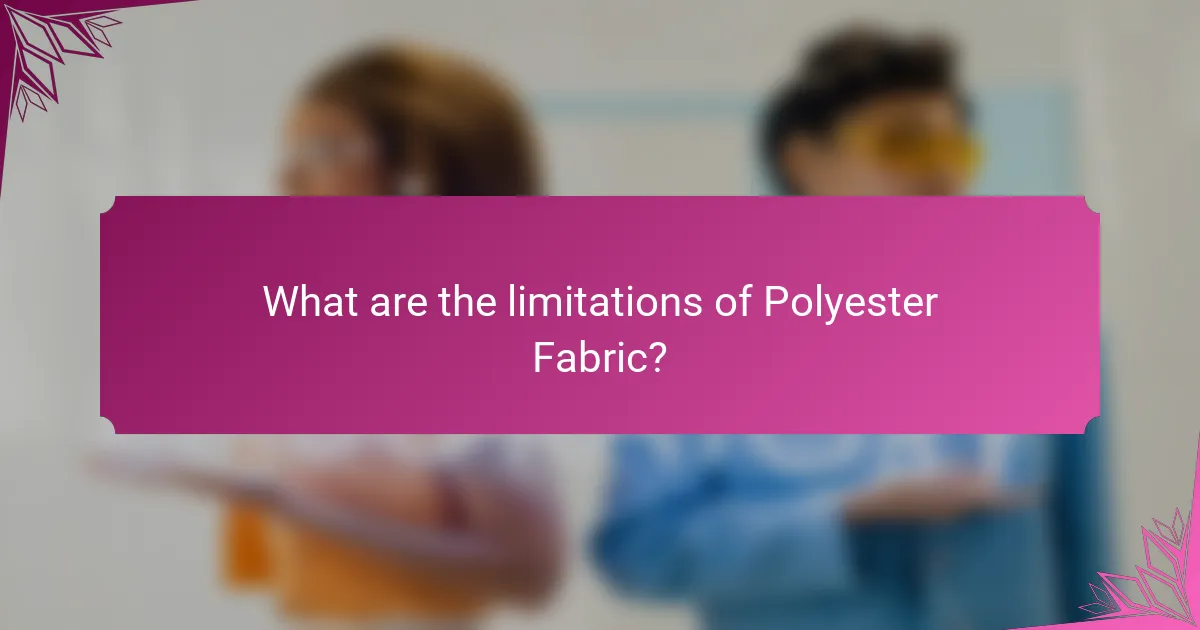
What are the limitations of Polyester Fabric?
Polyester fabric has several limitations. It is not as breathable as natural fibers like cotton. This can lead to discomfort in hot weather. Polyester is also prone to static cling and can attract pet hair and lint. Additionally, it may not be as durable as some other synthetic fabrics in terms of wear and tear. The fabric can also retain odors more than natural fibers. Furthermore, polyester is not biodegradable, contributing to environmental concerns. Lastly, it can be sensitive to high heat, which may cause melting or damage during washing or drying.
What are the environmental impacts of Polyester Fabric?
Polyester fabric has significant environmental impacts. It is derived from petroleum, a non-renewable resource. The production process releases greenhouse gases, contributing to climate change. Polyester is not biodegradable, persisting in landfills for hundreds of years. Microplastics from polyester garments pollute oceans and waterways. These microplastics harm marine life and enter the food chain. Recycling polyester can mitigate some impacts, but the infrastructure is limited. Overall, polyester’s environmental footprint raises concerns about sustainability.
How does the production of Polyester Fabric affect sustainability?
The production of polyester fabric significantly impacts sustainability. Polyester is derived from petroleum, a non-renewable resource. Its production process involves high energy consumption, contributing to greenhouse gas emissions. Additionally, the manufacturing generates water pollution due to chemicals used in dyeing and finishing processes. Recycling polyester can mitigate some environmental effects, but the recycling rate remains low. According to the Ellen MacArthur Foundation, only 14% of polyester is recycled globally. This low recycling rate exacerbates waste issues in landfills and oceans. Overall, the production of polyester fabric presents substantial sustainability challenges.
What are the options for recycling or disposing of Polyester Fabric?
Polyester fabric can be recycled or disposed of in several ways. Many municipalities offer textile recycling programs that accept polyester. These programs often repurpose the fabric into insulation, stuffing, or new textiles. Additionally, some retailers have take-back programs for used clothing, including polyester items. Donating polyester clothing to charities is another option. This extends the life of the fabric and helps those in need. If recycling or donation is not possible, polyester fabric should be disposed of in general waste. However, polyester is not biodegradable, so recycling is the preferred method.
What alternatives to Polyester Fabric exist?
Natural fibers such as cotton, linen, and hemp serve as alternatives to polyester fabric. Cotton is breathable and widely used in clothing. Linen offers durability and moisture-wicking properties. Hemp is eco-friendly and has natural antibacterial qualities. Additionally, rayon is a semi-synthetic fiber derived from wood pulp. It mimics the feel of silk and is biodegradable. Each alternative provides unique benefits in terms of comfort, sustainability, and usability.
What are the benefits of using natural fabrics over Polyester?
Natural fabrics offer several benefits over polyester. They are biodegradable, reducing environmental impact. Natural fibers, like cotton and linen, allow better air circulation. This enhances comfort and reduces moisture retention. Natural fabrics are less likely to cause skin irritation. They are also more sustainable, as they come from renewable resources. Additionally, natural fabrics can be more durable with proper care. Studies show that natural fibers can outperform polyester in breathability and comfort.
How do synthetic alternatives compare to Polyester Fabric?
Synthetic alternatives, such as nylon and acrylic, differ from polyester fabric in several ways. Polyester is known for its durability and resistance to stretching and shrinking. In contrast, nylon is stronger and more abrasion-resistant but can be less UV resistant than polyester. Acrylic offers a softer feel and is often used as a wool substitute, but it can be less durable than polyester.
Polyester is also hydrophobic, meaning it dries quickly, while nylon absorbs more moisture. Cost-wise, polyester is generally more affordable than both nylon and acrylic. Additionally, polyester maintains its shape well and resists wrinkles, unlike some synthetic alternatives. Overall, while synthetic alternatives offer unique benefits, polyester remains a popular choice for its balance of strength, affordability, and versatility.
What should you consider when choosing Polyester Fabric for your needs?
Consider the intended use of the polyester fabric. Different applications may require varying levels of durability and flexibility. Evaluate the fabric’s weight, as heavier fabrics often provide more durability. Assess the fabric’s texture, which affects comfort and suitability for clothing or upholstery. Check for moisture-wicking properties, especially for activewear. Review the fabric’s resistance to wrinkling and fading, which impacts maintenance and longevity. Investigate the environmental impact of the polyester, as recycled options may be available. Finally, consider the cost, as it varies based on quality and sourcing.
Polyester fabric is a synthetic textile known for its strength, affordability, and versatility. The article explores its production process, key characteristics, and advantages, highlighting its durability, quick-drying properties, and resistance to shrinking and wrinkling. It also discusses the environmental impacts of polyester, its care and maintenance, and alternatives to the fabric. Additionally, the article provides insights into the applications of polyester in various sectors, making it a popular choice in the textile industry.
